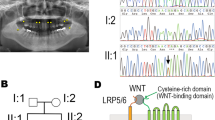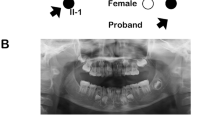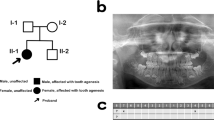Abstract
Even though selective tooth agenesis is the most common developmental anomaly of human dentition, its genetic background still remains poorly understood. To date, familial as well as sporadic forms of both hypodontia and oligodontia have been associated with mutations or polymorphisms ofMSX1, PAX9, AXIN2 andTGFα, whose protein products play a crucial role in odontogenesis. In the present report we described a novel mutation ofMSX1, which might be responsible for the lack of 14 permanent teeth in our proband. However, this c.581C>T transition, localized in a highly conserved homeobox sequence ofMSX1, was identified also in 2 healthy individuals from the proband’s family. Our finding suggests that this transition might be the first described mutation ofMSX1 that might be responsible for oligodontia and showing incomplete penetrance. It may also support the view that this common anomaly of human dentition might be an oligogenic trait caused by simultaneous mutations of different genes.
Similar content being viewed by others
References
Burzynski NJ, Escobar VH, 1983. Classification and genetics of numeric anomalies of dentition. Birth Defects Orig Artic Ser 19: 95–106.
Chi YI, 2005. Homeodomain revisited: a lesson from disease-causing mutations. Hum Genet 116: 433–444.
Das P, Hai M, Elcock C, Leal SM, Brown DT, Brook AH, et al. 2003. Novel missense mutations and a 288-bp exonic insertion in PAX9 in families with autosomal dominant hypodontia. Am J Med Genet 118: 35–42.
Das P, Stockton DW, Bauer C, Shaffer LG, D’Souza RN, Wright T, et al. 2002. Haploinsufficiency of PAX9 is associated with autosomal dominant hypodontia. Hum Genet 110: 371–376.
De Muynck S, Schollen E, Matthijs G, Verdonck A, Devriendt K, Carels C, 2004. A novel MSX1 mutation in hypodontia. Am J Med Genet 128: 401–403.
Frazier-Bowers SA, Guo DC, Cavender A, Xue L, Evans B, King T, et al. 2002. A novel mutation in human PAX9 causes molar oligodontia. J Dent Res 81: 129–133.
Hu G, Vastardis H, Bendall AJ, Wang Z, Logan M, Zhang H, et al. 1998. Haploinsufficiency of MSX1: a mechanism for selective tooth agenesis. Mol Cell Biol 18: 6044–6051.
Jezewski PA, Vieira AR, Nishimura C, Ludwig B, Johnson M, O’Brien SE, et al. 2003. Complete sequencing shows a role for MSX1 in non-syndromic cleft lip and palate. J Med Genet 40: 399–407.
Jumlongras D, Bei M, Stimson JM, Wang WF, DePalma SR, Seidman CE, et al. 2001. A nonsense mutation in MSX1 causes Witkop syndrome. Am J Hum Genet 69: 67–74.
Jumlongras D, Lin JY, Chapra A, Seidman CE, Seidman JG, Maas RL, et al. 2004. A novel missense mutation in the paired domain of PAX9 causes non-syndromic oligodontia. Hum Genet 114: 242–249.
Klein ML, Nieminen P, Lammi L, Niebuhr E, Kreiborg S, 2005. Novel mutation of the initiation codon of PAX9 causes oligodontia. J Dent Res 84: 43–47.
Lammi L, Arte S, Somer M, Jarvinen H, Lahermo P, Thesleff I, et al. 2004. Mutations in AXIN2 cause familial tooth agenesis and predispose to colorectal cancer. Am J Hum Genet 74: 1043–1050.
Lammi L, Halonen K, Pirinen S, Thesleff I, Arte S, Nieminen P, 2003. A missense mutation in PAX9 in a family with distinct phenotype of oligodontia. Eur J Hum Genet 11: 866–871.
Lidral AC, Reising BC, 2002. The role of MSX1 in human tooth agenesis. J Dent Res 81: 274–278.
Lidral AC, Romitti PA, Basart AM, Doetschman T, Leysens NJ, Daack-Hirsch S, et al. 1998. Association of MSX1 and TGFb3 with nonsyndromic clefting in humans. Am J Hum Genet 63: 557–568.
Mann GB, Fowler KJ, Gabriel A, Nice EC, Williams RL, Dunn AR, 1993. Mice with a null mutation of the TGF alpha gene have abnormal skin architecture, wavy hair, and curly whiskers and often develop corneal inflammation. Cell 73: 249–61.
Mostowska A, Biedziak B, Trzeciak WH, 2006. A novel mutation in PAX9 causes familial form of molar oligodontia. Eur J Hum Genet 14: 173–179.
Mostowska A, Kobielak A, Biedziak B, Trzeciak WH, 2003a. Novel mutation in the paired box sequence of PAX9 gene in a sporadic form of oligodontia. Eur J Oral Sci 111: 272–276.
Mostowska A, Kobielak A, Trzeciak WH, 2003b. Molecular basis of non-syndromic tooth agenesis: mutations of MSX1 and PAX9 reflect their role in patterning human dentition. Eur J Oral Sci 111: 365–370.
Nieminen P, Arte S, Tanner D, Paulin L, Alaluusua S, Thesleff I, 2001. Identification of a nonsense mutation in the PAX9 gene in molar oligodontia. Eur J Hum Genet 9: 743–674.
Ogawa T, Kapadia H, Wang B, D’Souza RN, 2005. Studies on Pax9-Msx1 protein interactions. Arch Oral Biol 50: 141–145.
Peters H, Balling R, 1999. Teeth: where and how to make them. Trends Genet 15: 59–65.
Peters H, Neubuser A, Kratochwil K, Balling R, 1998. Pax9-deficient mice lack pharyngeal pouch derivatives and teeth and exhibit craniofacial and limb abnormalities. Genes Dev 12: 2735–2747.
Satokata I, Maas R, 1994. Msx1 deficient mice exhibit cleft palate and abnormalities of craniofacial and tooth development. Nat Genet 6: 348–356.
Stockton DW, Das P, Goldenberg M, D’Souza RN, Patel PI, 2000. Mutation of PAX9 is associated with oligodontia. Nat Genet 24: 18–19.
Suzuki Y, Jezewski PA, Machida J, Watanabe Y, Shi M, Cooper ME, et al. 2004. In a Vietnamese population, MSX1 variants contribute to cleft lip and palate. Genet Med 6: 117–125.
Thesleff I, Sharpe P, 1997. Signalling networks regulating dental development. Mech Dev 67: 111–123.
Tucker AS, Al Khamis A, Sharpe PT, 1998. Interactions between Bmp-4 and Msx-1 act to restrict gene expression to odontogenic mesenchyme. Dev Dyn. 212: 533–539.
Van den Boogaard MJ, Dorland M, Beemer FA, van Amstel HK, 2000. MSX1 mutation is associated with orofacial clefting and tooth agenesis in humans. Nat Genet 24: 342–343.
Vastardis H, Karimbux N, Guthua SW, Seidman JG, Seidman CE, 1996. A human MSX1 homeodomain missense mutation causes selective tooth agenesis. Nat Genet 13: 417–421.
Vieira AR, Meira R, Modesto A, Murray JC, 2004. MSX1, PAX9 and TGFA contribute to tooth agenesis in humans. J Dent Res 83: 723–727.
Wang Z, Moult J, 2001. SNPs, protein structure, and disease. Hum Mutat 17: 263–270.
Yu HM, Jerchow B, Sheu TJ, Liu B, Costantini F, Puzas JE, et al. 2005. The role of Axin2 in calvarial morphogenesis and craniosynostosis. Development 132: 1995–2005.
Zhang YD, Chen Z, Song YQ, Liu C, Chen YP, 2005. Making a tooth: growth factors, transcription factors, and stem cells. Cell Res 15: 301–316.
Author information
Authors and Affiliations
Corresponding author
Rights and permissions
About this article
Cite this article
Mostowska, A., Biedziak, B. & Trzeciak, W.H. A novel c.581C>T transition localized in a highly conserved homeobox sequence ofMSX1: is it responsible for oligodontia?. J Appl Genet 47, 159–164 (2006). https://doi.org/10.1007/BF03194616
Received:
Accepted:
Issue Date:
DOI: https://doi.org/10.1007/BF03194616




